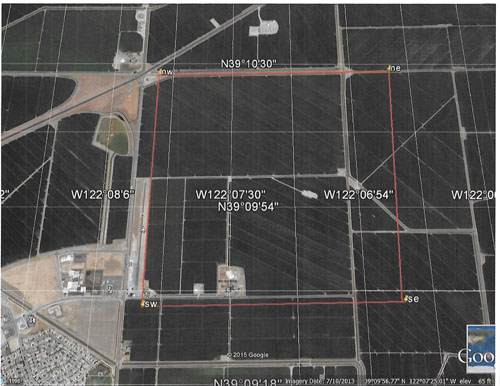Description of the Airfield
Here is a view of the runway, looking East....
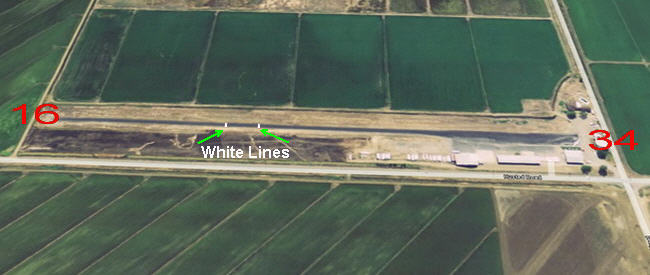
The airfield consists of a single paved runway running approximately North (34) and South (16), that has a useable length of approximately 1500 feet in length. A pair of white lines marks the touch down area for gliders landing on runway 16.
Unless you are taking off or landing, you should not be on the runway. The runway should be treated as a RESTRICTED area. An area that is only entered if you are in an aircraft that is landing or taking off. Movement of gliders and ground vehicles will be accomplished with minimal time on the South end of the runway. Depending on the weather and the wind, Gliders that have been assembled may be moved to the East side of the runway to tiedown or for staging. When gliders are landing to the North DO NOT park gliders on the East side of the runway.
Glider Assembly & Tiedown
- After assembly, do not leave the glider unattended until it is tied down.
- Consider the space required for gliders in adjacent trailers.
- Gliders should remain secured until being positioned for takeoff and should again be secured as soon as practical after landing to prevent injury or damage.
- Never leave the tail dolly installed if the glider will not be constantly controlled. Inadvertent rotation may occur suddenly with a gust of wind, if the tail dolly is installed.
[ Top of Page ]
TAKEOFF
Direction of Takeoffs and Landings
Takeoffs are only made to the north. Routinely the winds favor departures to the north, however, departures to the north are also accomplished with a tailwind.
Before becoming airborne, pilots should give consideration to the following when operating at Williams:
- Transient aircraft, unaware of our glider operations, often fly close to the field
- There are a wide variety of experience levels by participating pilots
- There is only a single runway operation, and space is limited
- There is a mixture of gliders and powered aircraft
- Departing traffic is always to the north, but landing traffic may be to the north or to the south.
- The parking ramp and all operations are at the south end of the field.
NOTE
Pilots are expected to evaluate the wind prior to every takeoff and landing. Pilots preparing to land, must make the decision to land in the direction they feel is safe.
[ Top of Page ]
Staging Gliders for Takeoff
When a glider is ready to takeoff, it should be positioned on the west side of the end of the runway, or at the south end of the runway pointed toward the north.
Here is photo of the glider launch area. Note gliders marked #1, #2:, and #3. On busy days WSC has a takeoff signup board, be sure to sign up for your take off position.
DO NOT take the #1 takeoff position unless you and your glider are 100% ready to go NOW.
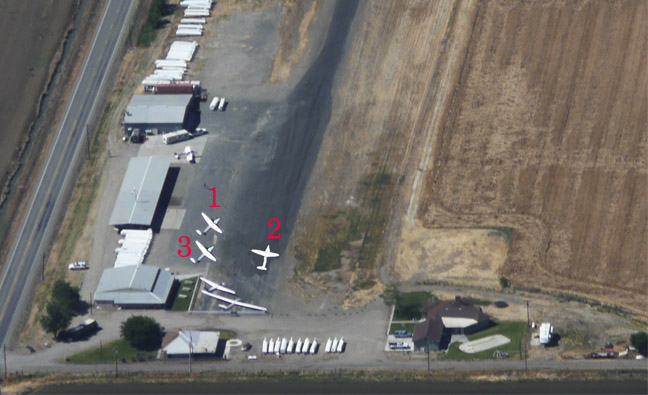
You can see in this illustration that Glider:
- #1 is not on the runway, but is in the "ready for takeoff position", which is adjacent to the south end of the runway.
- #2 is staged for takeoff, but on the very South end of the runway.
- #3 is staged for takeoff after the other gliders.
- If other gliders
are getting ready to launch, they should be staged
behind or along side of the other gliders with wing in back of other gliders wings.
- NOTE: The staging position used by glider #2 should NOT be used when gliders are landing to the North (runway 34).
Standard Visual Glider Signals
Standard visual signals should be used
at all times. The use of visual
signals, in conjunction with clear concise
radio communications will keep everyone aware
of the situation, even those on the field
who may not be monitoring the radio, but
are observing the operations.
Review the
standard visual signals.
Use of Radios
VHF Radio Frequency of 123.30 is the primary operating frequency at Williams Soaring Center. The call sign of the office at Williams is "Williams Base". The tow planes normally operate on 123.30. Radio Frequency 123.50 is also an authorized operating frequency for gliders, but is normally NOT monitored by staff personnel. CAUTION: Not all gliders have a radio.
When preparing for takeoff and landing, monitor radio frequency 123.30. Do NOT assume that no one is listening to the radio. If you have a radio available to you, then please use it. Make normal radio calls as recommended by the FAA, in the Airman's Information Manual. The radio is not a substitute for visual signals. The radio should be used in addition to the visual signals.
[ Top of Page ]
Tows
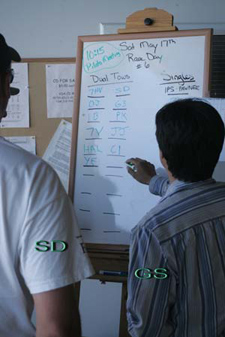 Williams
can be a very busy glider port, with over
30 tows in the busy take off period. On busy
days there is a sign up board. Be sure to
get on the board, and be ready when it is
your turn.
Williams
can be a very busy glider port, with over
30 tows in the busy take off period. On busy
days there is a sign up board. Be sure to
get on the board, and be ready when it is
your turn.
If you are not ready when the tow plane is
ready, you go to the end of the line.
The glider pilot should communicate with the tow pilot as necessary before the launch is initiated. Considerations should be given to discussing the following:
- wind on takeoff roll
- weight of the glider (water ballast, passengers)
- length and condition of the tow rope
- power of the tow plane
- direction of turn immediately after takeoff
- condition of emergency landing fields on departure
- expected location of the release
- release height of the tow
- towing speed (tows to the mountains are done at a higher speed!)
- other special circumstances
Training flights often turn towards the east on departure. On north wind days the tows may go straight ahead, into the wind. On most soaring days the departure flight path is to the west.
As illustrated by a red arrow in the following image, you can see a turn to the west is initiated before reaching the departure end of the runway. Besides keeping the glider closer to the field at low altitude, it is apparent that if an emergency landing were required, it would be more advantageous to be parallel to the rows of cultivation. From this perspective, looking towards the south, you can see the rows of cultivation.
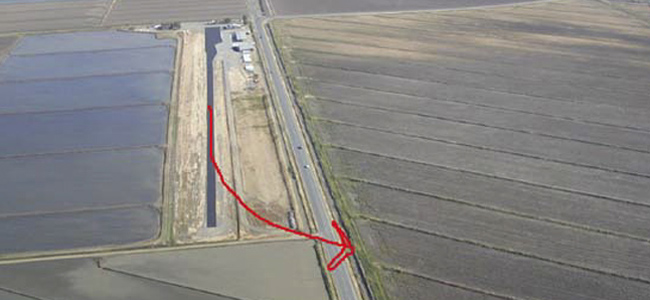
Here is an illustrated photo of the same track from the opposite perspective. In this photo, you are looking northward.
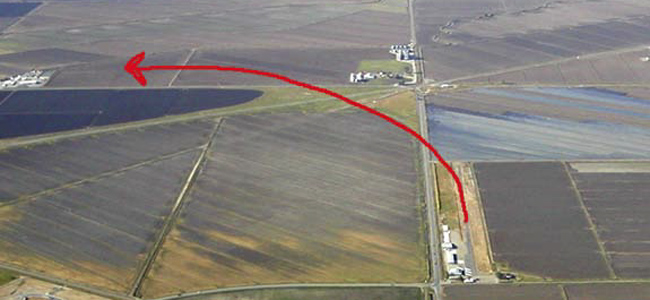
Study these two photos above one more time and consider the options that may be available to you in the event of a low altitude rope break. Keep in mind that the tow plane will normally be in a left turn immediately after becoming airborne.
Aborted Takeoffs
The tow plane will normally remain on the runway, and if possible, will stop straight ahead. As you can see in this photo looking to the south, there is sufficient room to avoid an over run collision. Review this photo and consider the options that may be available to you in the event of an aborted takeoff. The areas encircled with red pencil are drainage ditches. Since this photo is looking towards the south, you must visualize the tow plane and glider are coming towards you in this photo. Note that these are drainage ditches are parallel to the runway. On the east side, the canal/ drain ditch, is edged with a berm of high ground, and it runs nearly the entire length of the field. You are advised to not move excessively to the east.
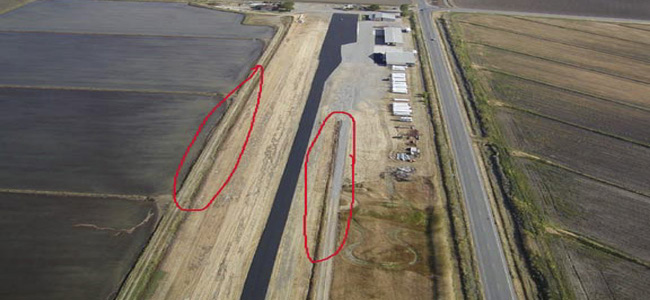
[ Top of Page ]
Rope Breaks
The following photo illustrates three possible rope break scenarios:
- Just after the tow plane starts a left turn, you may choose to land straight ahead, as indicated by the short blue arrow in this next illustration.
- At a slightly higher altitude, you may decide that the dirt road running to the south between the fields is a better option, and
- if you are high enough, you may decide that a right turn of 270 degrees would be your best option.
This illustration provides you with a view, as it appeared when the photo was taken. Undoubtedly, the fields have changed since then. Evaluate the existing conditions carefully on the day of your flight, and make the decision that you feel is best.
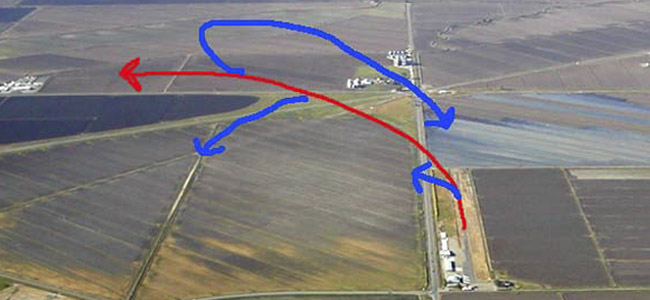
The runway is nearly surrounded by cultivated fields, with only a few structures in the vicinity of the gliderport. An emergency landing, resulting from a break of the tow rope or any other cause, should not be impeded by a lack of clear space. There are however, canals, dikes, fences, power lines, flooded fields, and rough ground to contend with during this type of emergency. Due to the changes caused by rain and agriculture, pilots should confer with a staff instructor and/or the tow pilot for recent changes in conditions, prior to launch, and should note recent changes themselves on each and every launch.
All pilots are reminded to be primarily concerned about safety, rather than to give consideration to convenience when selecting a place for an emergency landing.
LANDING
Returning to the Field for Landing.
All pilots are expected to return to the field with sufficient altitude to accomplish a normal traffic pattern. The normal traffic pattern altitude is 1,000 to 800 feet, with 800 considered the minimum altitude on downwind.
If you return to the airfield area with excess altitude, it is recommend that you cross to the east side of the field, and descend well clear of the downwind. This will allow others to see you and for you to see others that may be entering the traffic pattern. Here is an illustration of such a maneuver.
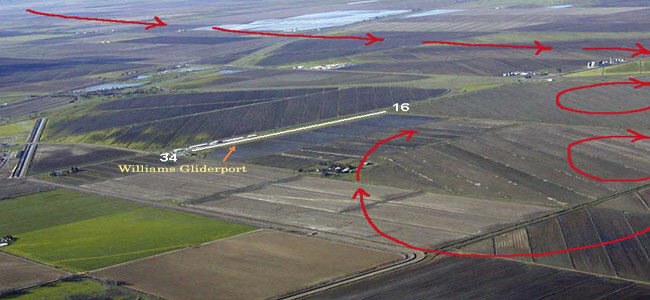
When not planning to enter the pattern on a 45 degree entry leg, be sure to announce when you are five minutes prior to landing, and clearly state your position and intentions when you are two minutes prior to landing. Continue to let other pilots know where you are, and continue to state your position and intentions
[ Top of Page ]
Landing Traffic Patterns
The routine direction for landing is to the south, but you may choose to land either to the south or to the north. The downwind leg for landing remains on the east side of the gliderport, regardless of whether the land north or south. This results in left hand traffic landing to the south on Runway 16, and right hand traffic when landing to the north on Runway 34.
NOTE
Pilots are expected to evaluate the wind prior to every landing. Pilots preparing to land, must make the decision to land in the direction they feel is safe.
The landmark called "Two Barns" is used as a reference for traffic pattern entry using a 45 degree entry leg, landing south.
Here is a photo showing "Two Barns" in the far distance (see red arrow). The 45 degree entry landing south, along with downwind and base leg are illustrated with blue arrows....
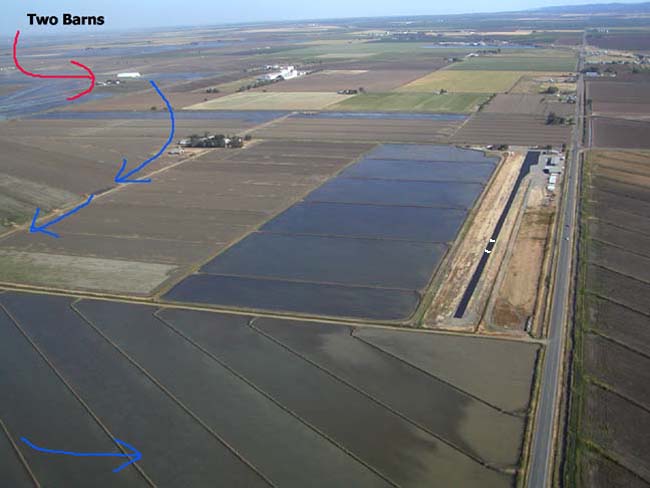
Landing to the South
The usable runway length, not including the overrun, is approximately 1500 feet. There are two white lines painted across the runway approximately 800 feet from the north end of the field.
This photo shows the two white lines with two possible rollout paths.

When landing to the south, touchdown between the two white lines. Manage your landing energy so that your can clear the active runway. Either roll to the glider assembly area north of the hanger (red line) or to the glider parking area near the office (blue line).
If you land prior to the white lines may not have enough energy to roll to the south end of the runway. The consequences of stopping on the runway are serious, especially if there are other gliders landing or taking off. You are expected to land between the white lines, and manage your landing energy so that you can taxi clear of the runway into the appropriate parking area.
Landing to the North
When landing to the north, you should NOT fly over the top of either of the houses. Your ground track should between the two houses, and you should not over fly personnel or aircraft near the approach end of the runway. Whether the field is soft or hard, your ground track of the final approach will normally be the same. The final approach ground track will normally be on a slight converging angle with the runway centerline.
Here is an illustration of the ground track when landing to the north (Green Line).
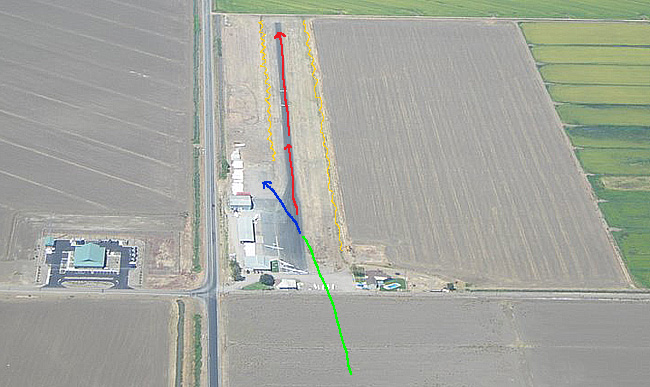
When landing to the North, there is a wide clear area in the vicinity of the end of the runway. Plan to land and roll to the hard packed area to the north east of the Shop Hanger. There should be no trailers, motor vehicles or other obstacles on the east side of the hangar during a north wind. The Yellow-Orange squiggly lines show the ditches on both sides of the runway.
[ Top of Page ]
Landing to the north during the DRY SEASON ( June - October)
Plan your approach so that you touch down on the sod. Your final approach will be slightly misaligned with the runway centerline, since your ground track was through the gap between the houses. If you land in the normal location, you should be slow enough to continue your rollout in a straight line, touching down on the sod, cross the asphalt runway, and continue in the direction of the glider assembly/ trailer parking area. If you overshoot the normal touch down area, and/or you are going too fast to continue safely in the direction of the trailer area, then you should realign your ground roll with the runway centerline, and remain on the runway. You must decide if it is prudent to continue straight ahead or make the slight right turn and remain on the hard surface. If you area landing too long to stop by the hanger continue down the mail runway to make room for gliders landing behind you.
Landing to the north during the WET SEASON ( November - May)
Plan your approach so that you are high enough, with enough energy, to align yourself with the runway centerline. Touchdown on the hard surface, and either continue straight down the runway, or, if you know the area to the west side is hard enough to support the glider, and you have the speed under control, you may turn off the runway on the west side before reaching the drain culvert. Do not risk going into the drain culvert. If you are unsure of your ability to stop before arriving at the drain culvert area, remain on the runway!
The red arrow in the previous photo illustrates a glider continuing on the runway, landing long to make room for a glider landing behind them.
Also in the previous photo, the blue line shows where a glider is touching down and rolling to a stop, off the runway, on the west side, in the glider assembly/ trailer parking area.
After Landing
- Pull your ship clear of the runway and the landing area.
- Always behave as if another aircraft will be landing soon (watch the skies, be aware!).
- Secure the aircraft, and remove the tail dolly before leaving it unattended.
- Pay Attention to other pilots & gliders. Do not block access to other glider trailers while you wash or work on your glider.
AEROBATIC BOX
The Williams Aerobatic Box is shown below. Pilots using the box should make a radio call on 123.3 stating that they are in the box between certain altitudes and for a certain duration. If other pilots are in the box or nearby they should announce their position and altitude and coordinate with the other pilots. It is the responsibility of all pilots flying at Williams to maintain situational awareness and be extra vigillant listening for radio calls activating the box and or the possibility of aerobatic in this area. Pilots using the box must also be extra vigalint for glider traffic along with all other types of air traffic announced or otherwise.
